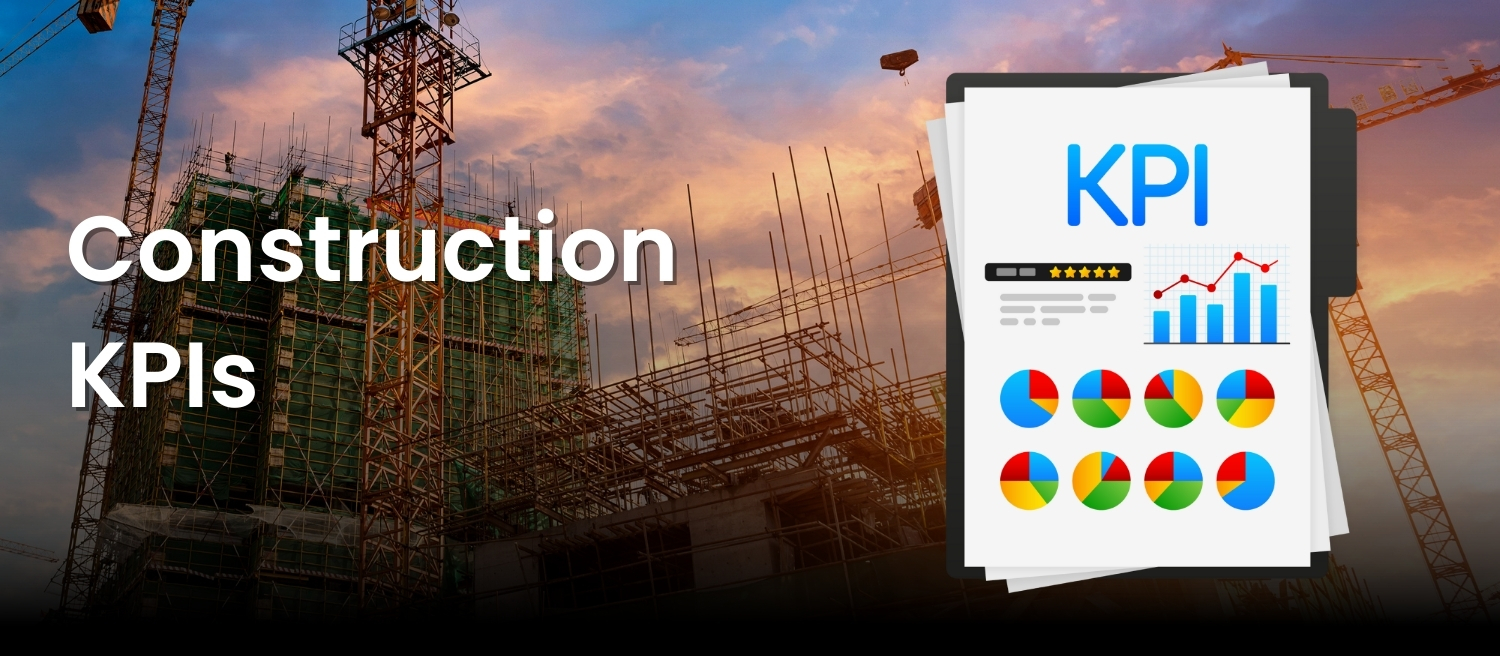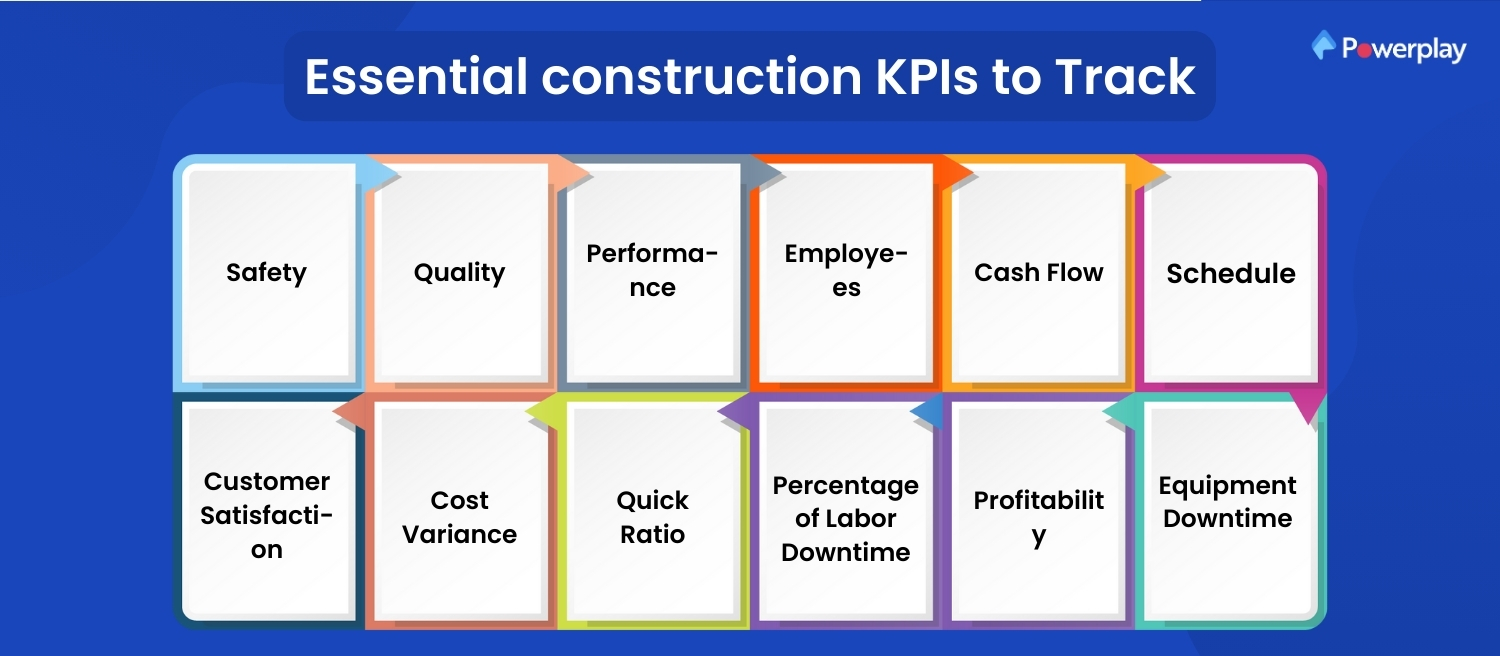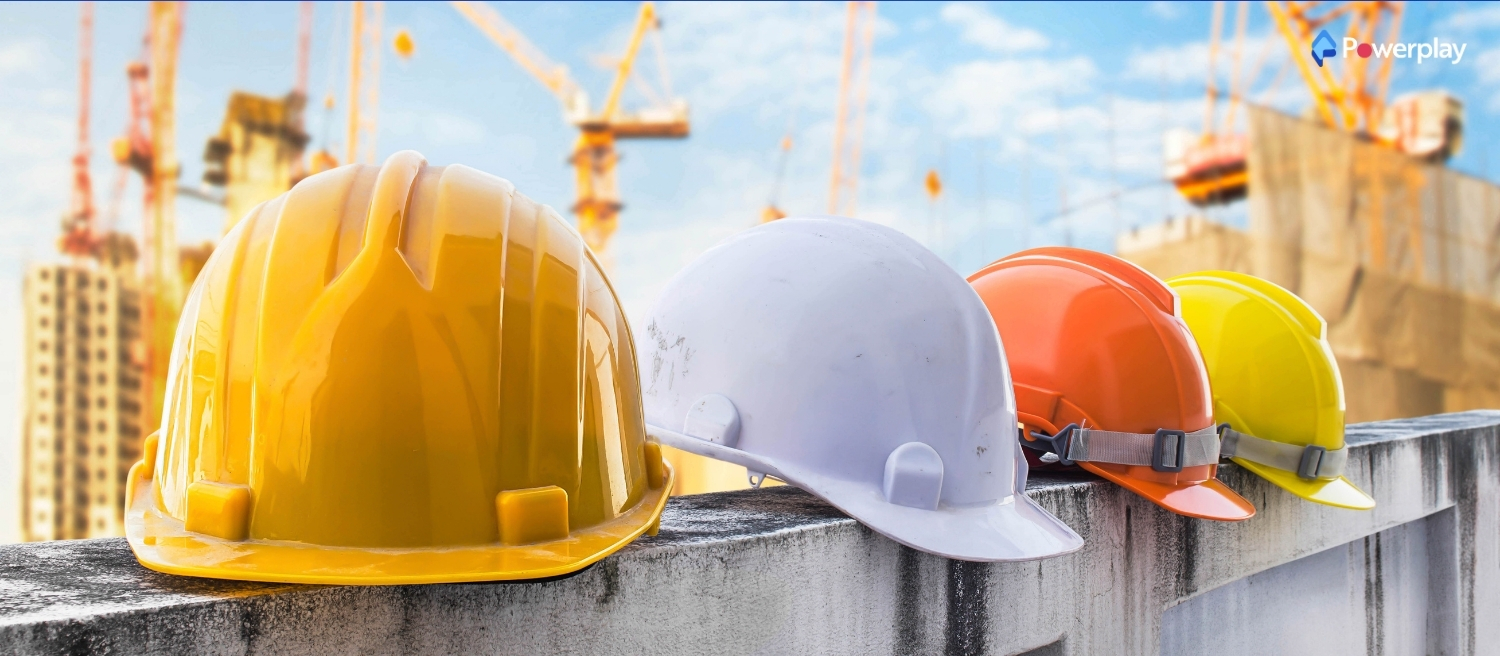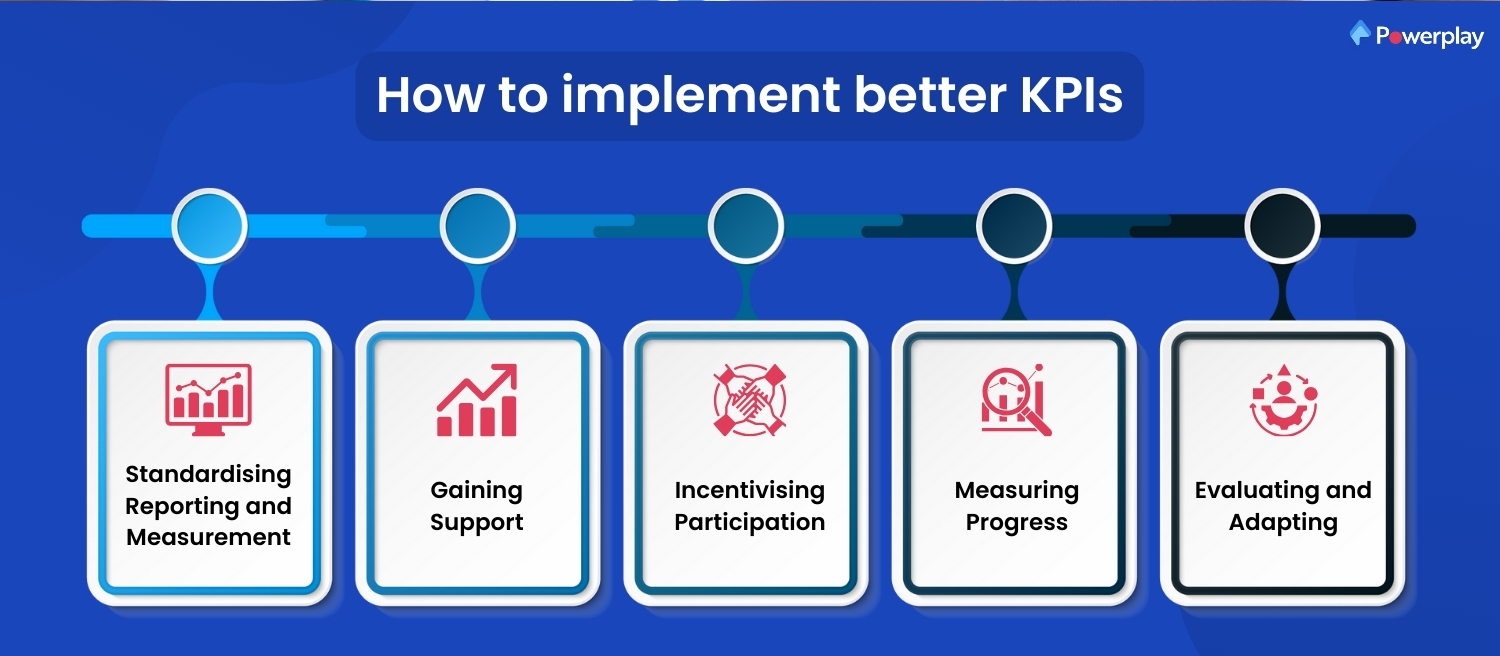12 Essential Construction KPIs for Construction Project
-
Sapna
- May 27, 2024

In the complex world of construction, effectively managing large-scale projects requires a deep understanding of multiple variables and factors. Key performance indicators (KPIs) are invaluable tools in this process, offering a streamlined approach to monitor and evaluate the critical aspects of a project’s health and progress. By focusing on a select set of meaningful metrics, construction managers can gain a clearer perspective on overall performance and business health.

In this blog, we will delve into 12 essential construction KPIs that provide a more comprehensive and effective way to gauge success for construction businesses. These KPIs will help you identify strengths, pinpoint areas requiring development, and make informed decisions to enhance the efficiency and outcome of your construction projects.
Table of Contents
What are construction KPIs?
Construction Key Performance Indicators (KPIs) are metrics used to evaluate the effectiveness and efficiency of various aspects of a construction project or business operations. They enable companies to measure performance against their objectives and make data-driven decisions to optimise processes.
Common KPIs in construction include financial metrics like profit, gross profit margin and net profit margins, and cash flow measures such as net cash flow and projected cash flow. Additionally, project management KPIs like milestone achievement and issue tracking are crucial for ensuring timely project completion and addressing potential problems. Other important KPIs involve labour productivity, equipment utilisation, and safety metrics like incident rates, which contribute to maintaining a safe and effective work environment.
Why are Construction KPIs important?
Construction Key Performance Indicators (KPIs) are crucial because they provide a measurable way to assess the effectiveness, efficiency, and progress of a construction project. They enable managers to identify areas needing improvement, optimise resource allocation, and ensure project completion on time and within budget.
By monitoring KPIs, businesses can enhance safety, and cost management improve quality, and increase productivity. Additionally, KPIs help in making informed decisions, improving stakeholder communication, and maintaining competitiveness in the industry by aligning project outcomes with business objectives.
Construction KPI assessment

Assessing Construction KPIs involves a systematic approach to ensure that the performance metrics accurately reflect the efficiency and success of construction projects. Here’s an outline of the process:
- Identify Relevant KPIs: Determine which KPIs are most important for the project or company goals. These could include metrics related to safety, quality, performance, employees, and cash flow.
- Set Baselines and Targets: Establish baselines for each KPI based on historical data or industry standards. Then, set realistic targets for improvement.
- Data Collection: Collect data systematically to measure each KPI. This might involve using software tools, manual tracking, or automated sensors.
- Analysis: Analyse the data to determine how well the project or company is performing against the set targets. Look for trends, patterns, and deviations.
- Actionable Insights: Use the analysis to identify areas for improvement. Develop action plans to solve any issues and optimise processes.
- Continuous Monitoring: Regularly monitor KPIs to track progress over time. Adjust targets and strategies as required based on ongoing assessments.
- Reporting and Communication: Share the results with stakeholders to ensure transparency and foster a culture of continuous improvement.
Essential construction KPIs to track

When it comes to Key Performance Indicators (KPIs) in the construction industry, the focus varies depending on the specific objectives and priorities of each construction company. Here, we explore several essential categories of KPIs that are pivotal for monitoring and enhancing various aspects of construction operations:
Safety:

This KPI focuses on the type, severity, and frequency of injuries at the construction job site. It includes metrics related to safety management practices like staff training, safety huddles, and the overall impact of safety incidents on the project schedule.
Quality:

Quality KPIs help ensure that construction projects meet the required standards and minimise later changes or corrections. This involves tracking issues in the quality checklist, the number of site inspections, and the rates of passed and failed inspections.
Performance:
Performance KPIs measure the effectiveness and productivity of construction operations. This can include metrics like cost variance, which compares the projected cost with the actual cost, and labour downtime, which measures unproductive time.
Employees:

KPIs related to employees focus on aspects like labor downtime, which reflects the productivity of workers, and other key metrics, that gauge employee engagement and performance throughout the project.
Cash Flow:

This involves tracking the efficiency of collecting payments (accounts receivable turnover) and the promptness in settling debts (accounts payable turnover). These KPIs help in understanding how well the business manages its finances during construction projects.
Schedule:
This KPI measures the adherence of the construction project to its planned timeline. Using project progress and comparing planned completion dates with actual dates helps identify delays and their causes. Effective schedule management ensures projects stay on track, reduces cost overruns, and maintains stakeholder satisfaction.
Customer Satisfaction:

This KPI assesses the level of satisfaction among clients with the quality and delivery of the construction project. High customer satisfaction can lead to repeated business and positive referrals, making it essential for long-term success. This client satisfaction metric can be evaluated through surveys, feedback forms, and direct client interactions.
Cost Variance:
This KPI compares the budgeted cost of work performed with the actual cost incurred. A positive variance indicates the project is under budget, while a negative variance suggests overruns. Managing cost variance effectively helps in maintaining financial health and profitability of the project.
Quick Ratio:
Also known as the acid-test ratio, this financial KPI measures a company’s ability to pay its short-term liabilities with its most liquid assets. A higher quick ratio indicates better liquidity and financial stability, which is crucial for managing unexpected costs or delays in construction.
Percentage of Labor Downtime:
This KPI tracks the proportion of time that labour is not productive due to delays, equipment failure, or other inefficiencies. Minimising labour downtime is key to maximising productivity and keeping the project on plan and within budget.
Profitability:

This KPI measures the overall financial success of a construction project by comparing the revenue it generates to the costs incurred. High profitability indicates efficient management and execution of project costs, while low profitability suggests areas for improvement in cost control and operational efficiency.
Equipment Downtime:
This KPI measures the time that equipment is not operational due to maintenance, breaks, or other issues. Reducing equipment downtime is essential for maintaining project momentum and avoiding costly delays.
Leading vs Lagging: moving to predictive KPIs
Understanding the difference between leading and lagging KPIs is crucial for moving towards predictive analytics and proactive decision-making in construction management.
Lagging KPI
Lagging KPIs are retrospective; they measure outcomes after they have occurred. Examples include total project cost, completed work quality, and accident rates. While they provide valuable insights into past performance, they don’t allow for immediate corrective actions.
Leading KPIs
Leading KPIs, on the other hand, are predictive and focus on future outcomes. They measure activities that influence future projects’ performance, such as employee training hours, equipment maintenance schedules, and the frequency of safety inspections. These KPIs can signal potential issues before they impact the project, allowing for preemptive adjustments.
To move towards predictive KPIs, the construction firms and managers should:
- Identify key leading indicators relevant to their specific project goals.
- Collect real-time data to monitor these indicators continuously.
- Use analytics to correlate leading indicators with lagging outcomes, refining predictions over time.
- Implement feedback loops to adjust operations based on predictive insights.
How to implement better KPIs

Implementing better KPIs (Key Performance Indicators) in any industry, including the construction business, involves a systematic approach to ensure they effectively guide and improve business performance. Here are the steps to enhance KPI implementation:
Standardising Reporting and Measurement:
To ensure consistency and accuracy in KPIs, it’s vital to standardise the reporting and measurement processes. This can be facilitated by adopting digital technologies and cloud-based systems that allow for real-time data sharing and standard workflow processes across the organisation.
Gaining Support:
For successful KPI implementation, securing buy-in from all stakeholders, including management and field workers, is crucial. This involves explaining the benefits of KPIs and providing training to key personnel who can advocate for their use.
Incentivising Participation:
Encouraging participation through mentorship and incentives such as rewards for meeting KPI targets can foster a culture where employees are motivated to engage with KPIs. This can lead to better data collection and adherence to performance standards.
Measuring Progress:
Assigning designated staff to track and report on KPI progress ensures that everyone is informed about how the company’s financial health is performing. Training on the use of performance software is also essential to maintain transparency and accountability.
Evaluating and Adapting:
Continually reviewing and refining KPIs is necessary to keep them relevant and effective. This involves setting aside time for discussion and embracing digital changes to adapt to evolving project dynamics.
How does Powerplay help to track construction KPLs?

Powerplay, a construction management software, assists in tracking construction KPIs by providing real-time data analytics and dashboard visualisations. It enables project managers to monitor key performance indicators such as project progress reports, material utilisation, labour productivity and budget adherence.
Powerplay integrates various project dimensions, allowing for a holistic view and facilitating decision-making. This ensures that teams can quickly identify deviations from planned metrics and take corrective actions, enhancing overall project efficiency and effectiveness.
Conclusion
In summary, the effective use of Key Performance Indicators (KPIs) is vital for the successful management of construction projects. By focusing on 12 essential KPIs, project managers can gain a complete view of their project’s performance, identify areas for development, and make informed decisions that enhance efficiency and outcomes.
These KPIs, ranging from safety and quality to profitability and equipment downtime, provide a balanced approach to evaluating the multifaceted aspects of construction operations. Adopting a proactive stance in keeping projects with leading KPIs and continually refining practices ensures that projects not only meet but exceed expectations, fostering a culture of excellence and sustained growth in the construction industry.













